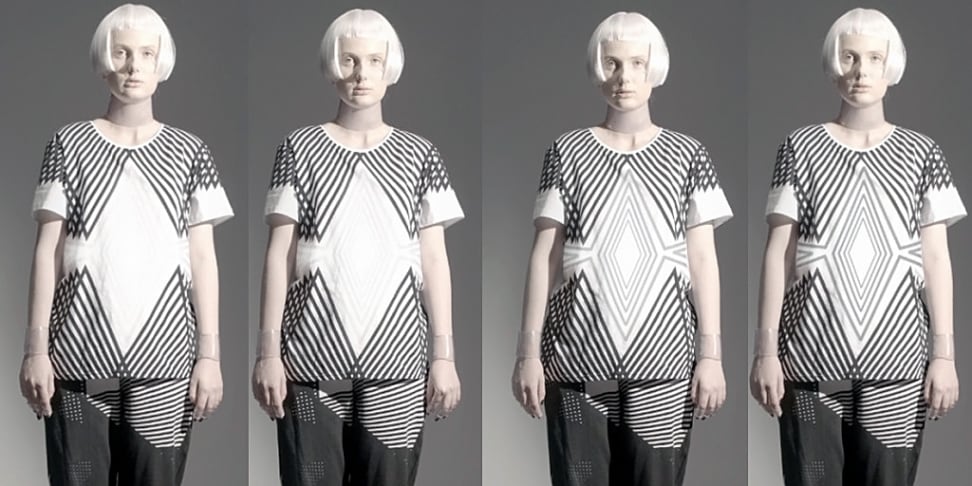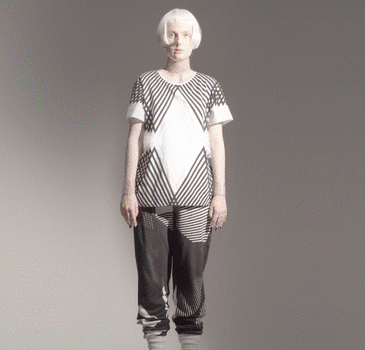Photocromia: Color-Changing Garbs Are Back in the Sunlight
These STEM-inspired clothes change color under UV light.
 Credit:
The Crated
Credit:
The Crated
Products are chosen independently by our editors. Purchases made through our links may earn us a commission.
Remember Hypercolor? Probably not.
They were clothes that changed color when exposed to heat, and they were all the rage—very, very briefly—back in the '90s. As soon as people realized that heat could also be generated by your body—and, you know, sweat—Hypercolor started to die off.
The idea, though, is interesting: clothes that can change their look based on environmental conditions. At the very least, that's something wearable tech makers could learn from. Madison Maxey, co-founder of The Crated, was one of the people intrigued by this idea, and recently she decided to take another stab at it.

The purpose behind the design is to help rethink the concept of wearables and our relationship with both the environment and our clothes.
Maxey teamed up with Mari Kussman, co-founder of the online design shop Print All Over Me, to develop a clothing line called Photochromia. The name is inspired by a type of photochromic ink called leuco dye, which was the same material used on Hypercolor clothes in the '90s. In this case, however, the fabrics were designed to react with UV light instead of heat.
At the moment, the entire Photochromia line consists of four items—a t-shirt, sweatshirt, hat, and backpack—each of which features a hidden pattern visible only under UV light. These designs are digitally printed onto the fabric using the clear leuco dye.
So unless you're out in the sunlight or in a room with UV lighting, the patterns won't be visible. (If you look closely, however, you can make out a faint impression of the design.) This is because the chemical structure of the dye starts to change when it's exposed to UV light, allowing it to absorb more light and change from clear to black. The darkness of the pattern is directly determined by the strength of the light.
Think of it as a clothing version of those special lenses that transition from spectacles to sunglasses when taken outside.

This accelerated video shows the transition of the clothing when exposed to UV light.
While the concept is intriguing, the inspiration for the actual designs isn't as transparent (see what I did there?). Each item is based on a STEM concept—that's "Science, Technology, Engineering, and Mathematics"—and might only be recognizable if you're already working in those fields. Some of the patterns include ASCII character art, a graphic translation of Schrodinger's Cat, and algorithmically-generated vector art.
Jesse Finkelstein, co-founder of Print All Over Me, explains, "The transition, while aesthetically pleasing, is also a literal reminder that what we wear, and how we wear it, are affected by our environment."
{{ photo_gallery name="Photochromia" }}
That's an important point, because the garment industry doesn't really have a great track record when it comes to labor ethics. According to the project's Kickstarter page, the factories used by Print All Over Me are ethically run with full-time employees that receive health benefits. That's certainly a nice step for the fashion industry, regardless of your interest in the threads.
Aesthetically, the garments are a bit polarizing (zing!). There's a very specific style the folks at Print All Over Me and The Crated are targeting, and that style is not likely to appeal to everyone—including myself.
But what do I know? This collaboration has a lot going for it; the Photochromia line aspires to make a mental connection between people, attire, and the environment that surrounds them. It's an aesthetic way of trying to tackle an abstract idea, and it just may get people to think differently about their clothes, their environment, and—we hope—a future of wearable tech that's not limited to smartwatches.
Related Video
{{brightcove '3823976332001'}}
